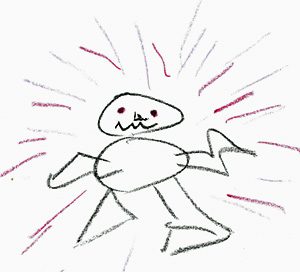Expressive & Art Therapy
 What is expressive therapy?
What is expressive therapy?
Expressive therapy is an umbrella term for approaches which aid self-expression, active participation, imagination and mind-body connections. This may include art therapy, psychodrama, and sandtray therapy.
Children, teens & adults
Expressive therapy is most often used with young children who have not yet developed the full capacity to express themselves verbally. However, it can be very valuable for many teens and adults, especially those who struggle to put their complex feeling into words. It can be particularly useful for people with visual or kinesthetic (body-based) modes of learning.
Trauma treatment
For clients of any age, expressive approaches can be particularly useful for trauma treatment. This is because traumatic memories are locked-in at a physical level. The traumatic effects often involve flash-backs, anxiety or spacing out which can feel impossible to talk about. Sometimes a simple drawing can powerfully communicate an emotional state or experience that would otherwise be impossible to describe in words: As they say, a picture paints a thousand words.
Approaches used
Art Therapy
Using art media such as paints, pastels, and collage can help clients express emotional conflict in circumstances where talk therapy is ineffective, resisted, or perhaps the client is not yet ready to talk. It is suitable for anyone, artist talents or not.
Drama Therapy
Sometimes roleplay can help a client make sense of a relationship which may be distressing, or to come to a place of resolution with someone from the past (working on ‘unfinished business’ in the present). For example, the client roleplays talking to his mother, and then roleplays his mother responding. Sometimes the therapist joins in, for example playing the part of a difficult boss or landlord. This can help the client develop self-assertion and self-confidence. Finishing a ‘scene’ in a different way often aids change, leading to understanding and personal growth.
Sandtray Therapy
Sandtray therapy is creative form of psychotherapy which uses a sandbox and a collection of miniatures to enable clients to explore the deeper layers of the mind. By constructing a series of ‘sand pictures’, a client can be helped to express what perhaps cannot yet be expressed verbally.
Gestalt Therapy
Gestalt therapy can be used to compliment expressive therapies. This method aims to help the individual to be self-supportive and self-responsible. The primary therapeutic tool is the development of awareness of what is going on within the self at any given moment, including awareness of body sensations. Gestalt’s objective is to enable clients to become more fully and creatively alive, allowing them to break free from ‘blocks’ and ‘unfinished business’ and to experiment with new ways of being.
Benefits of Expressive Therapy
- Self-expression: Helping clients communicate aspects of memories and stories that may not be available through conversation.
- Active participation: The experience of doing, making and creating can energise individuals, redirect attention and focus and alleviate emotional stress.
- Imagination: A healing agent in all forms of self-expression. People who have been traumatised or neglected or disturbed in some way may feel emotionally constricted. The therapeutic use of art, roleplay or sandtray, can develop the use of imagination, helping the client discover and develop corrective solutions, leading to change and resolution.
- Mind-body connections: Art and movement are particularly helpful in tapping the body’s relaxation response. The experiential and sensory nature of expressive therapies can help clients access a state before words were dominant. This approach can allow the brain to establish new, more productive patterns.
